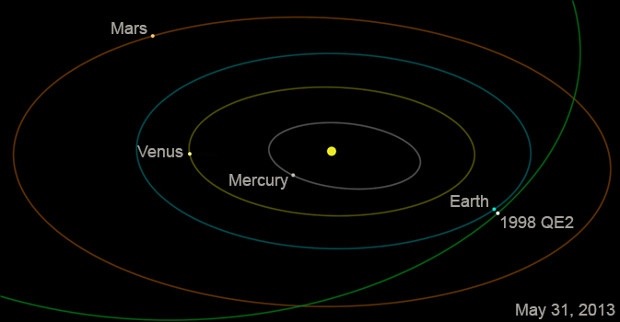Astroid QE2 1998 Expected To Fly By Earth’s Orbit On 31 May
On May 31, 2013, asteroid 1998 QE2 will sail serenely past Earth, getting no closer than about 3.6 million miles (5.8 million kilometers), or about 15 times the distance between Earth and the moon. And while QE2 is not of much interest to those astronomers and scientists on the lookout for hazardous asteroids, it is of interest to those who dabble in radar astronomy and have a 230-foot (70-meter) — or larger — radar telescope at their disposal.
According to NASA The closest approach of the asteroid occurs on May 31 at 1:59 p.m. Pacific (4:59 p.m. Eastern / 20:59 UTC). This is the closest approach the asteroid will make to Earth for at least the next two centuries. Asteroid 1998 QE2 was discovered on Aug. 19, 1998, by the Massachusetts Institute of Technology Lincoln Near Earth Asteroid Research (LINEAR) program near Socorro, New Mexico.
The asteroid, which is believed to be about 1.7 miles (2.7 kilometers) or nine Queen Elizabeth 2 ship-lengths in size, is not named after that 12-decked, transatlantic-crossing flagship for the Cunard Line. Instead, the name is assigned by the NASA-supported Minor Planet Center in Cambridge, Mass., which gives each newly discovered asteroid a provisional designation starting with the year of first detection, along with an alphanumeric code indicating the half-month it was discovered, and the sequence within that half-month.
Radar images from the Goldstone antenna could resolve features on the asteroid as small as 12 feet (3.75 meters) across, even from 4 million miles away.
It’s 1.7 miles long. Its surface is covered in a sticky black substance similar to the gunk at the bottom of a barbecue.
If it impacted Earth it would probably result in global extinction. Good thing it is just making a flyby.
Asteroid 1998 QE2 will make its closest pass to Earth on May 31 at 1:59 p.m. PDT. Scientists are not sure where this unusually large space rock, which was discovered 15 years ago, originated.
But the mysterious sooty substance on its surface could indicate it may be a result of a comet that flew too close to the sun, said Amy Mainzer, who tracks near-Earth objects at Jet Propulsion Laboratory in La Canada Flintridge, Calif.
It might also have leaked out of the asteroid belt between the orbits of Mars and Jupiter, she said.
We will know more after the asteroid zips closer to Earth and scientists using the Deep Space Network antenna in Goldstone, Calif., and the Arecibo Observatory in Puerto Rico can get a better look at it.
Astronomers at both observatories plan to track it closely from May 30 to June 9, according to a JPL release.
At its closest approach the asteroid will still be 3.6 million miles from our planet (about 15 times the distance between the Earth and the moon), but it will be close enough for these powerful radar antennas to see features as small as 12 feet across.
“With radar we can transform an object from a point of light into a small world with its own characteristics,” Lance Benner, JPL’s principal investigator for Goldstone radar observations, said in a statement.
There is no chance that asteroid 1998 QE2 could collide with Earth this go-around, and its next close approach won’t be until 2119.
Still, Mainzer said the size of the asteroid, and its potential for mass destruction, should remind us that there are some scary things flying around in space.
“This is a really big asteroid, similar in size to the one that killed off the dinosaurs, and it’s getting very close to us,” she said.
“Fortunately we’ve been tracking its orbit very carefully so we know with great certainty it won’t hit us.
“We don’t need to panic, but we do need to pay attention,” she said.













